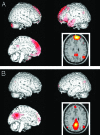Parietal cortex and representation of the mental Self
- PMID: 15096584
- PMCID: PMC404216
- DOI: 10.1073/pnas.0400049101
Parietal cortex and representation of the mental Self
Abstract
For a coherent and meaningful life, conscious self-representation is mandatory. Such explicit "autonoetic consciousness" is thought to emerge by retrieval of memory of personally experienced events ("episodic memory"). During episodic retrieval, functional imaging studies consistently show differential activity in medial prefrontal and medial parietal cortices. With positron-emission tomography, we here show that these medial regions are functionally connected and interact with lateral regions that are activated according to the degree of self-reference. During retrieval of previous judgments of Oneself, Best Friend, and the Danish Queen, activation increased in the left lateral temporal cortex and decreased in the right inferior parietal region with decreasing self-reference. Functionally, the former region was preferentially connected to medial prefrontal cortex, the latter to medial parietal. The medial parietal region may, then, be conceived of as a nodal structure in self-representation, functionally connected to both the right parietal and the medial prefrontal cortices. To determine whether medial parietal cortex in this network is essential for episodic memory retrieval with self-representation, we used transcranial magnetic stimulation over the region to transiently disturb neuronal circuitry. There was a decrease in the efficiency of retrieval of previous judgment of mental Self compared with retrieval of judgment of Other with transcranial magnetic stimulation at a latency of 160 ms, confirming the hypothesis. This network is strikingly similar to the network of the resting conscious state, suggesting that self-monitoring is a core function in resting consciousness.
Figures




References
-
- Flanagan, O. (1995) Consciousness Reconsidered (MIT Press, Cambridge, MA).
-
- Tulving, E. (1972) in Organization of Memory, eds. Tulving, E. & Donaldson, W. (Academic, New York), pp. 381-403.
-
- Cabeza, R. & Nyberg, L. (2000) J. Cognit. Neurosci. 12, 1-47. - PubMed
-
- Keenan, J. P. (2001) J. Consc. Stud. 3, 31-34.
Publication types
MeSH terms
LinkOut - more resources
Full Text Sources
Medical

